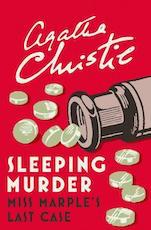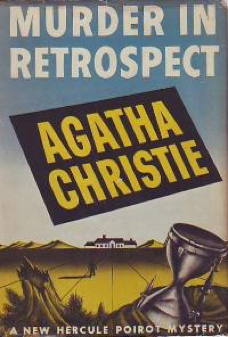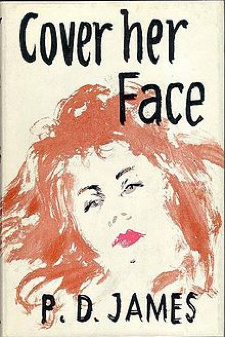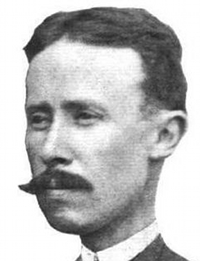
Poirot Score: 65
Sleeping Murder
☆☆☆
Reasons for the Poirot Score
The set up at the beginning is very good and there is one skilful misdirection and a good clue. A perfectly competent Christie novel but the red herrings and sub-plots are sketched in a rather desultory way, and apart from the murderer the possible suspects are barely integrated into the novel. There are flashes of the great Christie but for the most part she is writing on autopilot.
Click here for full review (spoilers ahead)
Trivia
When was Sleeping Murder written?
Sleeping Murder is written to be Miss Marple’s last case. Biographies state that Christie wrote both Sleeping Murder and Poirot’s last case, Curtain, in 1940 spurred on by the London blitz. She was being chased by the Inland Revenue for unpaid tax, her London house was unsafe because of the bombing, and she felt she needed to try to ensure future income for her family, a ‘nest egg’ in case of her sudden demise. The royalties for Sleeping Murder were given to Christie’s husband, Max, and those for Curtain to her daughter, Rosalind. Since both novels were written as the last cases for their respective detectives they were put on hold until Christie had stopped writing. Sleeping Murder was eventually published in 1976, ten months after Christie’s death.
By 1940 Christie had published only one novel, and one collection of short stories, featuring Miss Marple. By contrast she had already published twenty Poirot novels. It is strange, therefore, that she decided to write Marple’s final case before she had built up any significant Marple oeuvre. Tommy and Tuppence were more established at this stage in Christie’s writings. In chapter 22 of Sleeping Murder Colonel Melrose mentions two of Miss Marple’s successes as a detective. One case is the story of The Murder at the Vicarage – the one Miss Marple novel already published (in 1930). The other case clearly refers to The Moving Finger published in 1943.
Christie, on the whole, sets her novels at around the time she is writing them. Most of the novels written during the Second World War, however, seem to inhabit a peaceful, pre-war, world. At the start of Sleeping Murder Gwenda arrives by ship at the Devon port of Plymouth. She spends the next day ‘seeing Plymouth which she enjoyed’. Plymouth was devastated more by German bombing than almost any other British city. The Plymouth Blitz started in July 1940 and there were terrible bombing raids many times over the course of the war. Most of the city centre was destroyed and not rebuilt until the 1950s. There is no mention of this in the novel and the impression one has is of a pre-war Plymouth. But this does not help much with dating the writing of the novel.
Of more significance is what we are told near the beginning of chapter 3. Gwenda goes to London to visit Raymond West and his wife. The first evening they go to the ballet at Sadler’s Wells, and on the second evening to the “Witmore Theatre” (a made-up name) to see the actor John Gielgud in The Duchess of Malfi. When Gwenda leaves the theatre we are told that she ‘half walked, half ran” up the Haymarket. In fact John Gielgud did star in The Duchess of Malfi at the Theatre Royal in the Haymarket for a season in 1944-45. This points to the novel being written around, or later than, 1945.
It was not until John Curran studied Christie’s notebooks that it has become clear that Christie wrote Sleeping Murdermuch later than had previously been assumed. In an entry in her notebooks dated 1948 Christie outlines plot ideas that must relate to what eventually became Sleeping Murder. So at this point the book was still in the planning stages. Curran believes that the novel was not written until the late 1940s. By the end of 1950 four Miss Marple novels had been published so it makes more sense that Christie would write Miss Marple’s last novel after that. But once we jettison the idea that Christie wrote the novel because of fear of being killed during the war the grounds for writing a final Miss Marple mystery change. The most likely reason would be that Christie saw Marple as her major detective bar Poirot and that, like Poirot, she should be provided with a final case. Four novels seems rather few to consider Marple so significant but two further Marple novels had been published by 1953. Perhaps it was not until after writing A Pocket Full of Rye(published in 1953) that Christie turned her attention to Marple’s final case.

The many titles, and many detectives, in the making of Sleeping Murder
John Curran’s researches amongst Christie’s notebooks reveal the vicissitudes in the making of Sleeping Murder.
The title changed several times during the book’s slow incubation. The traces of this history can be seen in some of the chapter titles, rather as English place names can sustain a lingering memory of long lost features of a town or village. The title to chapter five, Murder in Retrospect, appears to have been an early possibility but this had to be abandoned when it was used by the American publishers for Five Little Pigs (which stars Poirot). The book title changed to Cover her Face, from the line in Webster’s The Duchess of Malfi, that plays a significant dramatic role in the novel. P.D. James, however, published a detective novel with this title in 1962, long after Christie’s novel had been written but before it was published. It remains as the title, however, to chapter 3 in Sleeping Murder. In 1972 Christie suggested to her agent the title She Died Young but this idea must have been rejected. The final title is a witty variant of the proverb let sleeping dogs lie. Miss Marple is asking her local doctor, Dr Haydock, what he would advise a person who had evidence, known to no-one else, that a murder had been committed twenty years ago. Dr Haydock replies: “Murder in retrospect. Sleeping murder. … I’d let sleeping murder lie”.
Christie also seems to have been uncertain as to which detective would feature. In the main blog we comment that the novel is in many ways more like a Tommy and Tuppence and that the presence of Miss Marple seems rather arbitrary. In one of the Notebooks (see p251 of Christie Christie’s Secret Notebooks by John Curran) Christie writes:
“Helen – Start with the house and the girl and Tuppence (?) or friend – Raymond West and wife – the things happening one by one – then the theatre – Malfi – a T and T story? A Miss M story? An HP story?”



Dunne – Experiment with Time
Wild fragments of explanation whirled round in her head. Dunne, Experiment with Time – seeing forward instead of back …
Chapter 2
In the quote above Gwenda has just bought a house on the South Coast in Devon – a house that as far as she knows she has never seen before – and yet it is eerily familiar. J.W. Dunne was an Irish engineer with an interest in spiritualism and a belief that dreams could foretell the future. His book Experiment with Time was first published in 1927. Dunne urges the reader to follow his example and record, immediately upon waking, the content of his dreams. Dunne claims that on the basis of his experiments, and those of some of his friends, the content of dreams includes images relating to experiences from both the past 24 hours and the future 24 hours in roughly equal proportions. He builds a metaphysics of time on the basis of these observations in which all experiences are timeless. Past and future are artefacts of our waking mind. The deeper structure is of an eternal present.

Madeleine Smith and Lizzie Borden
People say a murderer always repeats his crimes. That’s not true. There’s a type who commits a crime, manages to get away with it, and is darned careful never to stick his neck out again. … Perhaps that was so in the case of Madeleine Smith or again in the case of Lizzie Borden.
Dr Haydock talking to Miss Marple, Chapter 5
[Lizzie Borden is also mentioned in The Moving Finger and Elephants Can Remember]
The playground rhyme that I remember from school in London in the 1950s goes:
Lizzie Borden took and axe
And gave her mother forty whacks.
When she saw what she had done
She gave her father forty-one.
In 1892 in Fall River, Massachusetts, Lizzie Borden’s father and stepmother were killed from 11 and 18 blows respectively. The murders were known as the axe murders. Lizzie was charged with their murder. Her trial took place in June 1893. She was acquitted of the murder and no-one else was ever charged. Lizzie Borden died in 1927 at the age of 66 years.

Madeleine Smith, whose father and maternal grandfather were both eminent architects, was brought up in Glasgow. She had a secret affair with a nurseryman, Pierre Emile L’Angelier. In 1857, when she wished to break off her relationship, she asked L’Angelier to give back her letters. He refused, threatening to expose her and force their marriage. A short while later L’Angelier died from arsenic poisoning. When Smith’s letters were found at L’Angelier’s house she was charged with murder. There was evidence that she had bought arsenic a short while earlier but the jury at her trial brought in a verdict of not proven. After the trial she left Scotland and lived for many years in London. She married the business manager of William Morris – the leading figure of the Arts and Crafts movement. After their separation she moved to New York where she died in 1928 at the age of 93.

